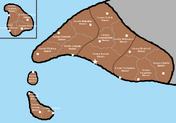| Dovmark Province of Dovmark Provins Dovmark | |
|---|---|
| Province | |
 File:N/A File:N/AFlag and Coat of Arms | |
|
Map of Dovmark | |
| Country | Davostag |
| Administrative center | Dovborg |
| • Largest city | Saint Erwinsburg |
| Government | |
| • Governor | Placeholder |
| • Legislative body | Provincial Assembly |
| • Governing party | Placeholder |
| Area | |
| • Total | 100,200 km² |
| Population | |
| • Total | 3,209,227 |
Dovmark, also known as Dovland, historically known as Davograd, and originally named Dovsk, is one of the five regions of Davostag. The region is the largest island of the country and is the westernmost region of the five. Dovmark is the fourth largest region but holds the largest population of over 3.2 million people.
Etymology[]
Dovmark is considered to be the cultural center of the Davostani people, hence why it is named "Dovmark", the Skrigere word for "Davostan". The original name "Dovsk" was the origin of the word Dovskere, meaning "Davostanis", first coined and used by Kivonian scholars to refer to the Davostagian Skrigeres.
Geography[]
Cities of Dovmark[]
| Name in Luthorian | Name in native languages | Description |
|---|---|---|
| N/A | Guldholt | N/A |
| N/A | Engelshøj | N/A |
| N/A | Sankt Erwinsburg | N/A |
| N/A | Dovborg | N/A |
Government[]
Dovmark's government is dominated by the current Kivonian National Salvation Party since 4754, when the Second Noble Socialist Party fled the country to Telamon. It is governed by a Governor, who chairs the Provincial Assembly.

Administrative regions[]
- Greater Guldholt
- Greater Engelshhøj
- Greater Favrkilde
- Greater Dovborg
Politics[]
Recent politics in Dovmark has been relatively dominated by the Noble Socialists, who has always been able to maintain a good stronghold over the island, especially against the National Salvationists.
Geography and Climate[]

Arctic whales of Dovmark
Dovmark is a volcanic island that broke away from Dorvik in ancient times. Its size is 100,200 km2. Periodically, the main volcano on Dovmark will erupt causing massive environmental effects in the area. The interior of Dovmark is mountainous with little civilization. The vast majority of the population is located on coastal cities.
Dovmark has a subarctic climate but with strong maritime influences that moderate temperatures. In regards to rainfall, the climate has semi-arid influences. Most of the precipitation falls in late summer. Average daytime summer temperatures range from approximately 55 to 78 °F (13 to 26 °C); average daytime winter temperatures are about 5 to 30 °F (-15 to -1.1 °C). Average January low and high temperatures are 11 to 23 °F (-12 to -5 °C) with an average winter snowfall of 75.5 inches (192 cm). The interior of Dovmark is significantly colder than the coastal cities due to higher elevation.
Economics[]

Nuclear Plant in Dovmark
In the interior of Dovmark are various mining operations of precious metals and ore. Deforestation of the island's forests is also a major occupation. The fishing industry is present in every coastal city. Dovmark is also a leading sponsor in geothermal and nuclear energy production to meet is energy needs.
Dovmark has created a number of ferry systems to transport people and goods to the mainland and to the island regions of Nyberg and Bindeborg Proper. Before the transportation infrastructure was set up, Dovmark had been fairly isolated from the rest of the Macon continent.

